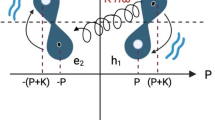Abstract
THE establishment of a theory which would satisfactorily predict the relationship between molecular structure and plant hormone activity would be of major importance in improving our fundamental knowledge of plant growth regulation and would be of great practical significance to the agrochemical industry. The subject of auxin structure–activity relationships has been widely reviewed1–7 but each theory has been found, in some respect, defective. Techniques of theoretical chemistry, biochemistry and plant physiology are used here to draw attention to the probability that charge separation as a component of the structural requirements for auxin activity has been prematurely6 rejected.
This is a preview of subscription content, access via your institution
Access options
Subscribe to this journal
Receive 51 print issues and online access
$199.00 per year
only $3.90 per issue
Buy this article
- Purchase on Springer Link
- Instant access to full article PDF
Prices may be subject to local taxes which are calculated during checkout
Similar content being viewed by others
References
Koepfli, J. B., Thimann, K. V. & Went, F. W. J. biol. Chem. 122, 763–780 (1938).
Veldstra, H. Enzymologia 11, 97–136, 137–163 (1944); A. Rev. Pl. Physiol. 4, 151–198 (1953).
Jonsson, A. Svensk kem. Tidskr. 67, 166–187 (1955); in Encyclopaedia of Plant Physiology 14, 959–1006 (Springer, Berlin, 1961).
Fredga, A. & Åberg, B. A. Rev. Pl. Physiol. 16, 53–72 (1965).
Audus, L. J. Plant Growth Substances I: Chemistry and Physiology (Leonard Hill, London, 1972).
Kaethner, T. M. Nature 267, 19–23 (1977).
Thimann, K. V. A. Rev. Pl. Physiol. 14, 1–18 (1963).
Porter, W. L. thesis, Harvard Univ. (1962).
Thimann, K. V. Am. J. Bot. 23, 561–569 (1936).
Thimann, K. V. & Porter, W. L. in Proc. 4th Int. Conf. Plant Growth Regulation 444–445 (Iowa State University Press, 1961).
Elliott, M. C., Farrimond, J. A., Hall, J. F. & Clack, D. W. in Plant Growth Regulators (eds Kudrev, T., Ivanova, I. & Karanov, E.) 459–463 (Bulgarian Academy of Sciences, 1977).
Thimann, K. V. in Hormonal Regulation of Plant Growth and Development (eds Kaldewey, H. & Vardar, Y.) 155–170 (Proc. Adv. Study Inst., Izmir, 1971).
Pople, J. A., Santry, D. P. & Segal, G. A. J. chem. Phys. 43, S129 (1965).
Sundberg, R. J. (ed.) in The Chemistry of Indoles 18, 1–3 (Academic, New York, 1970).
Toothill, J., Wain, R. L. & Wightman, F. Ann. appl. Biol. 44, 547–560 (1956).
Fawcett, C. H., Osborne, D. J., Wain, R. L. & Walker, R. D. Ann. appl. Biol. 40, 231–243 (1953).
Stuart, R. & Street, H. E. J. exp. Bot. 20, 556–557 (1969).
Author information
Authors and Affiliations
Rights and permissions
About this article
Cite this article
FARRIMOND, J., ELLIOTT, M. & CLACK, D. Charge separation as a component of the structural requirements for hormone activity. Nature 274, 401–402 (1978). https://doi.org/10.1038/274401a0
Received:
Accepted:
Issue Date:
DOI: https://doi.org/10.1038/274401a0
This article is cited by
-
The effect of indomethacin on the growth and metabolism of green alga Chlorella vulgaris Beijerinck
Plant Growth Regulation (2008)
-
Mechanism of auxin perception by the TIR1 ubiquitin ligase
Nature (2007)
-
Mediation of Herbicide Effects by Hormone Interactions
Journal of Plant Growth Regulation (2003)
Comments
By submitting a comment you agree to abide by our Terms and Community Guidelines. If you find something abusive or that does not comply with our terms or guidelines please flag it as inappropriate.



